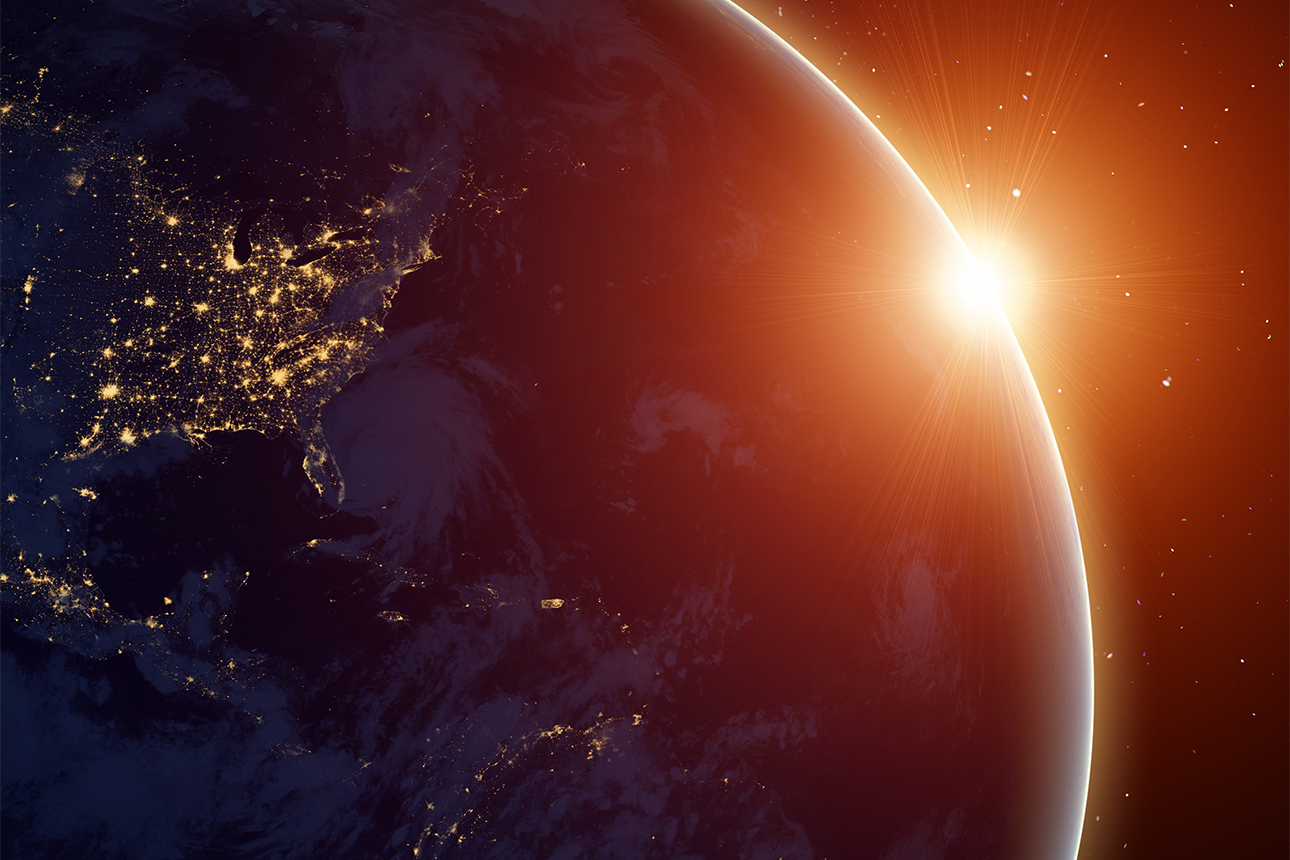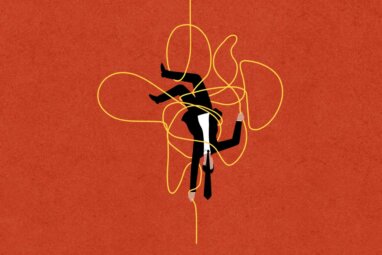Monitoring the COVID-19 Crisis From Space
A comparison of nighttime light emissions across China during the early months of COVID-19 shows how satellite sensing data can provide early detection of trouble.

Business leaders across the globe are increasingly dismayed at feeling left in the dark about the size and severity of the COVID-19 outbreak. Suppliers in affected countries, such as China, are no longer able to confirm orders. The stock and oil markets are in disarray. Governments worldwide have been slow to report on the true scale of the economic slowdown. The lack of reliable, timely, inexpensive, and easy-to-obtain information about the severity and impact of COVID-19 has revealed a glaring weakness in global management.
One source of data we rely on in our economic research can provide a clear picture of the economic impact of COVID-19 and similar disasters. Nighttime light emissions data, a novel class of remote sensing data, measures the total amount of light produced at night in a given region. It can be used by businesses, such as airlines, to monitor progression and effects of significant continuity threats, such as natural disasters and civil unrest, as well as economic recovery in near real time and at little cost. Nighttime light emissions have the potential to reduce reliance on slow-moving government statistics and questionable media reporting, and the data can be used to augment or replace other less timely and less accurate economic proxies to see when and where industry-related activity is changing.
We believe that the analysis of this data can be used to help managers and senior leaders navigate existential threats, such as the COVID-19 pandemic, by providing early warning about the impact of episodes in regions where they might have operations, suppliers, or customers.
What Remote Sensing Data Is Showing
Our large-scale research project of daily data at the Global Center for Entrepreneurship and Innovation at the University of St. Gallen in Switzerland uses remote sensing data from satellites and other sources to monitor short-term changes in economic and social activity.
We have found that satellite nighttime light emissions data is particularly effective at quantifying the economic and social impact of COVID-19. Nighttime light emissions are a strong proxy for economic activity: One recent report from the International Monetary Fund found that light emissions alone can be used to measure more than 44% of the variation in a nation’s per capita gross domestic product. Several prior studies have had even stronger predictive results, using light emissions to quantify local economic activity, local levels of income, and electricity usage. These results have allowed researchers to track changes in economic activity and monitor conflicts and natural disasters.
Our team analyzed light emissions data from the Visible Infrared Imaging Radiometer Suite (VIIRS), a joint endeavor by the United States National Oceanic and Atmospheric Administration (NOAA) and NASA. VIIRS has near-daily global coverage and is sensitive enough to detect light emission changes that are not observable from other remote sensing platforms. (See “Shanghai at Night Before the COVID-19 Outbreak.”) VIIRS allows us to quickly identify where, exactly, locales in China affected by COVID-19 have seen the largest decreases in economic activity — insights that are nearly impossible to make in a timely manner through government-issued statistics or traditional proxies of economic activity.
Nighttime light data shows that COVID-19 has had a clear and discernable impact on almost all major Chinese cities. (See “China’s Liaoning Province Reacts to COVID-19.”) The data shows a consistent pattern in which peripheral industrial regions had reduced light emissions in January and February compared with pre-pandemic patterns. We also find a consistent pattern of light emission reductions from dense city centers in more affected areas. This indicates a sharp reduction of non-industry-related activity, which corresponds to the effect COVID-19 is expected to have had on China’s service sector.
We were surprised by the severity of the reduction in light emissions along intercity highways. Satellite-based remote sensing data is able to capture this reduction across an entire region at the same point in time. Changes in transportation usage, as with the pattern of light emission reductions from dense city centers, correspond closely with changes in total economic activity.
Another surprising insight: Our results suggest that Chinese citizens started self-isolating before the government quarantines — earlier than commonly believed. Our findings indicate that throughout January, Chinese citizens in northern regions began restricting their activity more than Chinese citizens elsewhere. A comparison of nighttime light emissions in Beijing and several surrounding cities showed a marked reduction in light emissions almost a week before the start of the Jan. 23-24 quarantines in Hubei Province. Our results also show that the level of reaction to COVID-19, as measured by nighttime light emissions, was markedly different across Chinese regions, including those with similar infection rates. We believe that companies doing business in affected regions can use this type of information to identify potential disruptions before they occur and respond accordingly.
How Companies Can Use Remote Sensing Data
The most crucial attribute for successfully navigating the coming weeks and months is strong, sustained, and committed leadership at all levels of your company. However, leaders are blind without accurate and timely information. We strongly believe that this emerging class of satellite-based remote sensing data, when used appropriately, provides opportunities for unique insights:
Sensing data can provide early detection of trouble points. The tracking of light emissions along intercity highways and other changes in both transportation and pollution emissions monitoring is funded by national governments or international organizations, and the data from these platforms is, in almost all cases, publicly available. Businesses can use this to better understand the severity of COVID-19 across different regions and more accurately and more quickly understand potential threats to their supply chains or areas of operation.
Monitoring allows near real-time overview of certain threats. With appropriate tools and skill sets, companies can integrate remote sensing data with other early warning indicators to provide a steady stream of data about certain types of natural disasters and other business continuity threats as well as the eventual economic recovery. For example, governments around the world have started to use cell phone-based GPS tracking data to enforce social distancing policies and other quarantine measures.
Organizations have also turned to automobile tracking data to get insights into the ongoing economic recovery in China. Companies, such as those in the airline industry, could begin integrating remote sensing data with individual tracking data to start identifying local increases in economic and social activity, which could serve as an early indication of a positive shift in demand. While analyzing these data packages requires some training, tacit knowledge, and technical skills, finding potential employees or training existing ones is not necessarily out of reach for most companies. Over time, data processing and analysis can be automated, further reducing costs.
Data can unearth the unexpected. One of the surprising findings from our data is that some Chinese citizens were prepared to react quickly to a potential existential threat, as shown by the apparent reduction in travel and other observable social activities around Beijing up to a week prior to the start of the first quarantine. That this period of time also corresponds with the heaviest travel period in the country, Chinese New Year, makes these results even more remarkable.
Similarly, we were surprised to see that the level of reaction to COVID-19 was different in Chinese cities that otherwise had the same relative outcomes. Conventional wisdom suggests that cities relatively closer to Hubei Province, such as Changsha in Hunan Province, or cities with a history of dealing with repeated pandemic threats, such as Guangzhou in Guangdong Province, should have reacted more strongly to COVID-19. However, although most cities saw some reduction in light emissions, cities in northern and eastern China, such as Qingdao, Beijing, and Shenyang, reacted more severely, and in some cases more quickly, than their counterparts elsewhere. Again, this type of information can help companies doing business in affected regions to identify disruptions in real time, rather than waiting for official statistics, which may be slow, inaccurate, and without local data.
The length of time it has taken countries around the world to treat COVID-19 as a serious threat shows that many governments and supporting international organizations have been caught unprepared. This lack of preparedness has manifested in unreliable statistics and insufficient communication. Companies are now being attacked by an existential threat, the impact and severity of which is difficult to ascertain.
Senior leaders need access to timely and accurate information to manage what is an inherently daunting challenge. They should constantly seek out new sources of reliable and actionable data. Combined with other real-time proxies for consumer behavior, such as geolocation data and credit card transactions as well as more novel sources of information such as ground emission monitoring stations, social media posts, and traffic congestion readings, nighttime light emissions data can help leaders detect economic trends during a time of crisis with a level of timeliness once unimaginable.
The method can also complement the current efforts by governments to track social distancing using cell phone data. For example, data protection laws limit the global sharing of mobile carriers’ data, but remote sensing data can be used to define global benchmarks and learn from the worldwide patterns of social distancing. This method of insight can provide organizations with increased visibility into the ongoing crisis and a strong and sustainable competitive advantage going forward.








